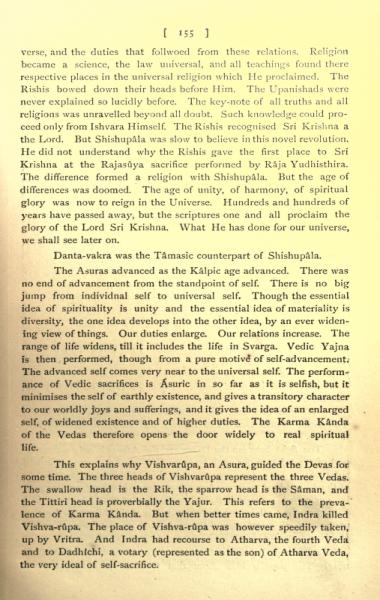 p154 _
-chap- _
toc-1 _
p155w _
toc-2 _
+chap+ _
p156
p154 _
-chap- _
toc-1 _
p155w _
toc-2 _
+chap+ _
p156
----- bhagap155.html
verse, and the duties that folhvoed from these relations. Religion
became a science, the law universal, and all teachings found there
respective places in the universal religion which He proclaimed. The
Rishis bowed down their heads before Him. The Upanishads were
never explained so lucidly before. The key-note of all truths and all
religions was unravelled beyond all doubt. Such knowledge could pro-
ceed only from Ishvara Himself. The Rishis recognised Sri Krishna a
the Lord. But Shishupala was slow to believe in this novel revolution.
He did not understand why the Rishis gave the first place to Sri
Krishna at the Rajasuya sacrifice performed by Raja Yudhisthira.
The difference formed a religion with Shishupala. But the age of
differences was doomed. The age of unity, of harmony, of spiritual
glory was now to reign in the Universe. Hundreds and hundreds of
years have passed away, but the scriptures one and all proclaim the
glory of the Lord Sri Krishna. What He has done for our universe,
we shall see later on.
Danta-vakra was the Tamasic counterpart of Shishupala.
The Asuras advanced as the Kalpic age advanced. There was
no end of advancement from the standpoint of self. There is no big
jump from individnal self to universal self. Though the essential
idea of spirituality is unity and the essential idea of materiality is
diversity, the one idea develops into the other idea, by an ever widen-
ing view of things. Our duties enlarge. Our relations increase. The
range of life widens, till it includes the life in Svarga. Vedic Yajna
is then performed, though from a pure motive of self-advancement.
The advanced self comes very near to the universal self. The perform-
ance of Vedic sacrifices is Asuric in so far as it is selfish, but it
minimises the self of earthly existence, and gives a transitory character
to our worldly joys and sufferings, and it gives the idea of an enlarged
self, of widened existence and of higher duties. The Karma Kanda
of the Vedas therefore opens the door widely to real spiritual
life.
This explains why Vishvarupa, an Asura, guided the Devas for
some time. The three heads of Vishvarupa represent the three Vedas.
The swallow head is the Rik, the sparrow head is the Saman, and
the Tittiri head is proverbially the Yajur. This refers to the preva-
lence of Karma Kanda. But when better times came, Indra killed
Vishva-rupa. The place of Vishva-rupa was however speedily taken,
up by Vritra. And Indra had recourse to Atharva, the fourth Veda
and to Dadhfchi, a votary (represented as the son) of Atharva Veda,
the very ideal of self-sacrifice.
[[155]]
p154 _
-chap- _
toc-1 _
p155w _
toc-2 _
+chap+ _
p156
v?
 p154 _
-chap- _
toc-1 _
p155w _
toc-2 _
+chap+ _
p156
p154 _
-chap- _
toc-1 _
p155w _
toc-2 _
+chap+ _
p156